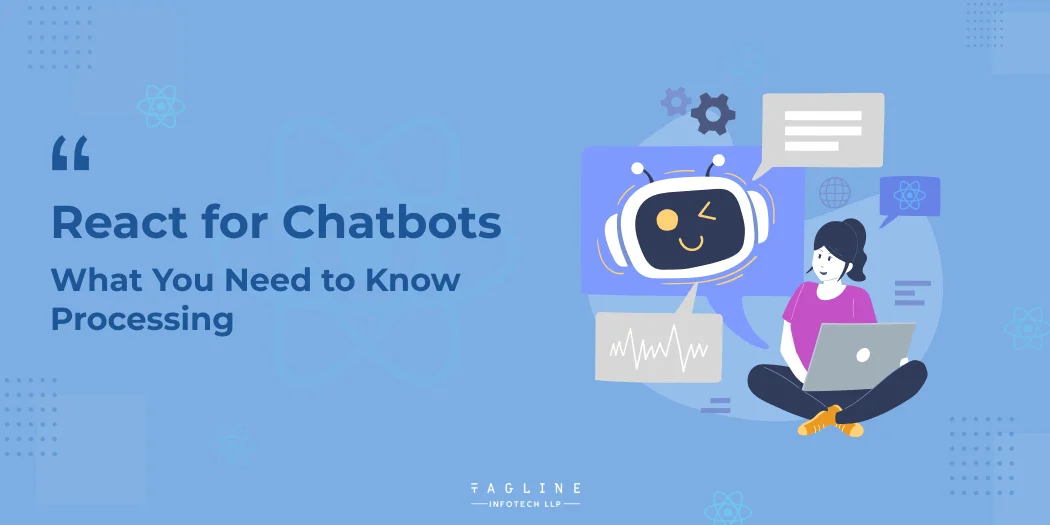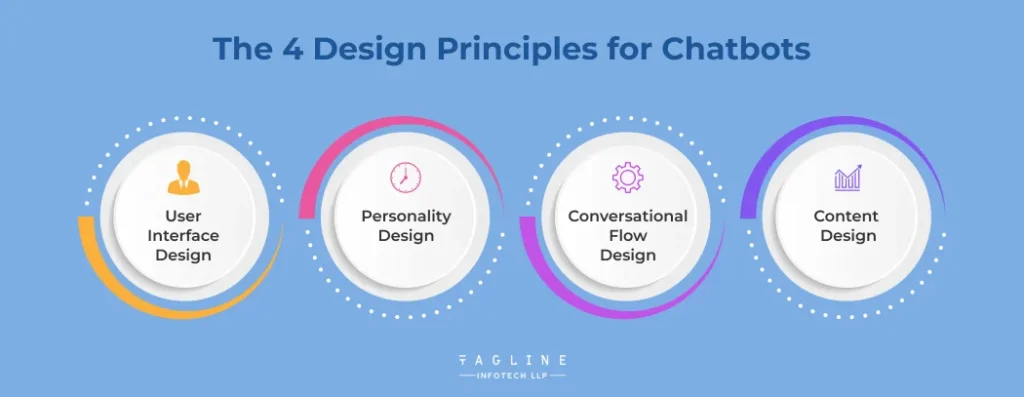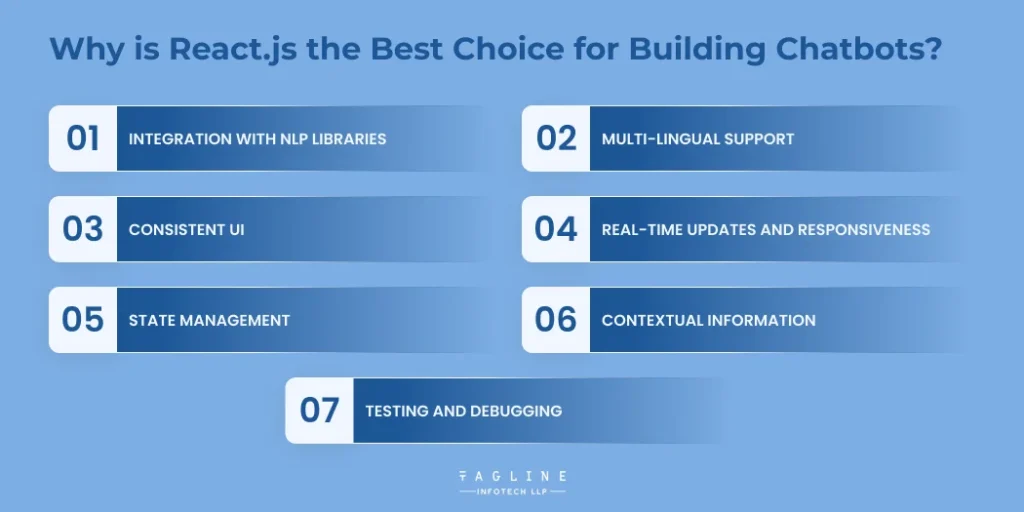Role of Python Libraries in Image Processing
October 30, 2025
Home >> ReactJS >> React for Chatbots: What You Need to Know

Quick Summary
Engaging customers on your website efficiently can be quite challenging, especially when providing prompt responses and reducing waiting times. Relying solely on human agents would require a significant investment to handle every customer interaction. However, investing in a chatbot offers a cost-effective solution. By using React for chatbots, you can promptly address numerous customer inquiries simultaneously, enhancing customer satisfaction and fostering long-term relationships. Implementing chatbots with React provides a scalable and dynamic approach, making it an ideal strategy for your business to improve user engagement and streamline customer support.
In the digital age, instant gratification is key to keeping users engaged. A slow response can lead to users abandoning your site, costing you potential revenue. Many businesses now turn to chatbots to provide swift customer service on their websites and apps. A study by Tidio, a leading customer service software shows that chatbots are popular in countries like the United States, Germany, the United Kingdom, India, and Brazil.
However, implementing a React chatbot goes beyond just adding it to your site. It’s vital to choose the right frontend technology, design the chatbot effectively, and enhance the overall user experience.
React is an excellent choice for building visually appealing and interactive user interfaces for chatbots. With Tagline Infotech’s expertise, you can create an intuitive chatbot design that captivates your audience. In this guide discover the full potential of using React for your chatbot solutions and boost user engagement.
React is an open-source JavaScript library that’s perfect for developing web UIs, making it an ideal choice for integrating chatbots into your application or website. Here’s why chatbot in React JS is crucial for integration:
Integrating React with NLP libraries like Dialogflow or Wit.ai enables chatbots to communicate with users more naturally. NLP allows chatbots to accurately interpret user intent and context, delivering precise responses. Not only this but chatbots can perform sentiment analysis, recognizing the emotional tone of interactions and adjusting their responses accordingly. This ensures personalized and context-aware communication. Utilizing React alongside NLP greatly improves the chatbot’s responsiveness and effectiveness.
Adding multiple language options helps users get their questions answered quickly in their preferred language. This is especially useful for serving international customers. Companies can also adapt their content for specific regions, including local text and images. This approach makes the experience feel more familiar to users in different areas. Overall, supporting multiple languages helps increase brand recognition on a global scale.
React makes chatbot development more efficient and flexible. Its component structure allows for a consistent interface while enabling easy customization for different clients. The framework supports real-time updates, enhancing user engagement. React’s responsive design ensures the chatbot works well across various devices and screen sizes. Also, React facilitates the creation of dynamic and intuitive chatbot interactions, improving the overall user experience.
When it comes to managing conversations, React’s state management tools make it easier for chatbots to handle complex interactions in a way that feels natural and intuitive. By keeping track of user inputs and conversation history, these tools help the bot respond in a more human-like manner and maintain a seamless dialogue across multiple interactions.
One of the standout features of state management in React is its ability to address mistakes and guide users through potential errors. If a user encounters a problem, the bot can use this information to offer helpful feedback and educate users on how to avoid similar issues in the future. This not only improves the user experience but also helps build a more effective and reliable chatbot.
React developers can connect your chatbot to various APIs for services like weather updates or news feeds, ensuring it provides accurate and current information. These integrations enable your chatbot to interact with external platforms, such as social media or e-commerce sites, offering tailored and engaging user experiences. With chatbot integration in React JS, you can enhance your chatbot’s functionality, delivering a more relevant and interactive experience for users.
React’s support for ARIA attributes and keyboard navigation makes chatbots more accessible for users with disabilities. ARIA attributes help screen readers convey how the chatbot works, guiding users through interactions. Keyboard navigation ensures that users who can’t use a mouse can still navigate and use the chatbot effectively.
Also, React enables features like alternative text for images and options for color contrast, making the chatbot accessible to visually impaired users and ensuring a more inclusive experience for everyone.
Users often look for answers tailored to their location, browsing history, or device type. Leveraging this contextual information can significantly boost the customer experience with personalized suggestions and recommendations. For example, a chatbot could use a user’s location to recommend nearby restaurants, movie theaters, or shopping centers, making the conversation more relevant and helpful. This approach not only addresses users’ immediate needs but also enhances engagement by offering timely and location-based suggestions that cater to their specific interests.
For a chatbot to work smoothly, thorough testing is essential. React developers use the Jest testing framework to rigorously test and debug the chatbot’s code, ensuring it runs efficiently and performs as expected.
This rigorous testing process is key to maintaining a functional and reliable chatbot, helping you make the most of React for your chatbot development needs.
The potential of your chatbot is largely determined by these development principles. Ignoring them can lead to less successful results. Let’s take a closer look at each principle to set your chatbot up for success.
NLP is essential for your chatbot to deliver fast, accurate responses. It helps the chatbot understand user inputs and provide relevant replies, enhancing user experience and your brand’s reputation.
Machine Learning (ML) improves a chatbot’s performance by learning from past interactions to refine future responses. This speeds up reply times and boosts the chatbot’s ability to handle various queries, improving user satisfaction.
Effective user experience design is vital for a successful chatbot. It involves creating intuitive interfaces, optimizing conversation flows, and choosing appealing color schemes to ensure the chatbot is engaging and user-friendly.
Contextual understanding enables a chatbot to interpret user intent and provide relevant responses. Training the chatbot for contextual awareness ensures accurate and meaningful interactions and enhances the overall chatbot experience.

Create a user-friendly interface with an intuitive layout, readable typography, and an appealing color scheme. Ensuring the interface is accessible to all users, including those with disabilities, is crucial for customer engagement.
Design your chatbot with a personality that mirrors your brand’s voice and character. A well-crafted personality reinforces your brand’s identity and creates a more engaging user experience.
Develop a clear conversational flow that guides users towards business goals, such as making a purchase or signing up for a service. Effective flow anticipates user questions and drives successful outcomes.
Focus on delivering clear, accurate responses to user queries. Well-designed content enhances engagement and satisfaction by providing useful information during interactions.

In our fast-paced digital world, chatbots have become a key tool for businesses looking to automate customer service, improve user interactions, and streamline operations. While there are many frameworks and libraries out there for building chatbots, React.js stands out as one of the most popular and effective options.
Listed down are some advantages of React.js for building robust chatbots
Natural Language Processing (NLP) is a key area of artificial intelligence that empowers chatbots to interpret and interact using human language. When combined with React.js and advanced NLP libraries such as TensorFlow.js or Natural, chatbots can greatly enhance their abilities to understand user inquiries, perform sentiment analysis, identify entities, and classify intents. These capabilities enable chatbots to deliver more precise and contextually appropriate responses, improving user engagement and satisfaction. A Reactjs Development Company can leverage React.js’s adaptable framework to facilitate the integration of these NLP tools, allowing developers to enhance chatbot functionality and meet contemporary user needs effectively.
As businesses expand globally, multi-lingual support becomes essential for chatbots. React.js facilitates the creation of chatbots that cater to diverse linguistic needs through internationalization (i18n) libraries like React-Intl. This feature simplifies the translation and localization of chatbot interfaces, allowing developers to manage multiple languages efficiently. By leveraging React-Intl, you can create language-specific components and manage translations, which helps in reaching a broader audience and improving user engagement across different regions.
Maintaining a consistent user interface (UI) is fundamental for chatbot success. React.js’s component-based architecture offers a robust solution for creating reusable UI elements that ensure a cohesive and polished appearance across the entire chatbot. By utilizing a virtual DOM, React.js applies updates efficiently, enhancing performance and speeding up rendering. This approach not only helps maintain a uniform look and feel but also ensures that the chatbot interface aligns with your brand’s visual identity.
React.js excels in real-time updates, a vital feature for interactive chatbots. The virtual DOM efficiently updates only the parts of the chatbot that have changed, providing quick and seamless interactions without needing to reload the entire page. This capability supports dynamic content updates, allowing the chatbot to offer real-time responses and engage users effectively. Additionally, React.js’s component-based design facilitates modular updates, making it easier to manage and enhance different aspects of the chatbot’s interface
Effective react state management is critical for dynamic chatbot development. React.js’s use of props and state provides a powerful framework for managing data and interactions within a chatbot. These features allow developers to track user inputs, handle external events, and manage chatbot behavior dynamically. By leveraging React.js’s state management capabilities, developers can create responsive chatbots that adjust to user needs and deliver relevant, tailored interactions.
Delivering contextual information is key to a successful chatbot experience. React.js’s component-based design supports the creation of modular, flexible components that manage specific functionalities and integrate contextual data. This design approach allows chatbots to adapt to user interactions and provide relevant information, enhancing the overall user experience. By effectively managing context, chatbots can offer personalized interactions that meet users’ individual needs and preferences.
Ensuring chatbot reliability requires thorough testing and debugging. React.js provides a suite of tools for these processes, including Jest for unit testing and Enzyme for component testing. React DevTools further aids in debugging by allowing developers to inspect component structures, state, and props. These tools collectively help maintain high-quality, effective chatbots, ensuring that they perform well and meet user expectations through rigorous testing and debugging practices.
In today’s digital world, chatbots are essential for effective customer engagement. They provide instant, reliable responses that human support alone can’t always deliver. A well-designed chatbot on your website can greatly enhance user experience.
React is perfect for creating advanced, interactive chatbots with dynamic interfaces and efficient query management. Skilled React developers can help you leverage this framework to meet customer expectations and build high-quality chatbots.
Hire expert React developers from Tagline Infotech to craft a standout chatbot that boosts user satisfaction and integrates seamlessly with your web application. Don’t miss the chance to improve your customer service—start your chatbot project with us today.
React.js is a versatile framework for user interface development and chatbots. Its component-based approach enables reusable elements, which helps streamline the development and consistency of chatbot interfaces.
Absolutely yes! React.js makes it easy to deploy your chatbot across various platforms, including as a web app, within existing websites, or integrated with messaging services such as Facebook Messenger and Slack.
React developers should pay careful attention to the responsiveness and design of chatbots for mobile devices, ensuring that the chatbot is touch-sensitive and designed to minimize data consumption for a better user experience.
A Quick Guide to Chatbot Integration in React
Created with Solvase

Digital Valley, 423, Apple Square, beside Lajamni Chowk, Mota Varachha, Surat, Gujarat 394101
D-401, titanium city center, 100 feet anand nagar road, Ahmedabad-380015
+91 9913 808 2851133 Sampley Ln Leander, Texas, 78641
52 Godalming Avenue, wallington, London - SM6 8NW